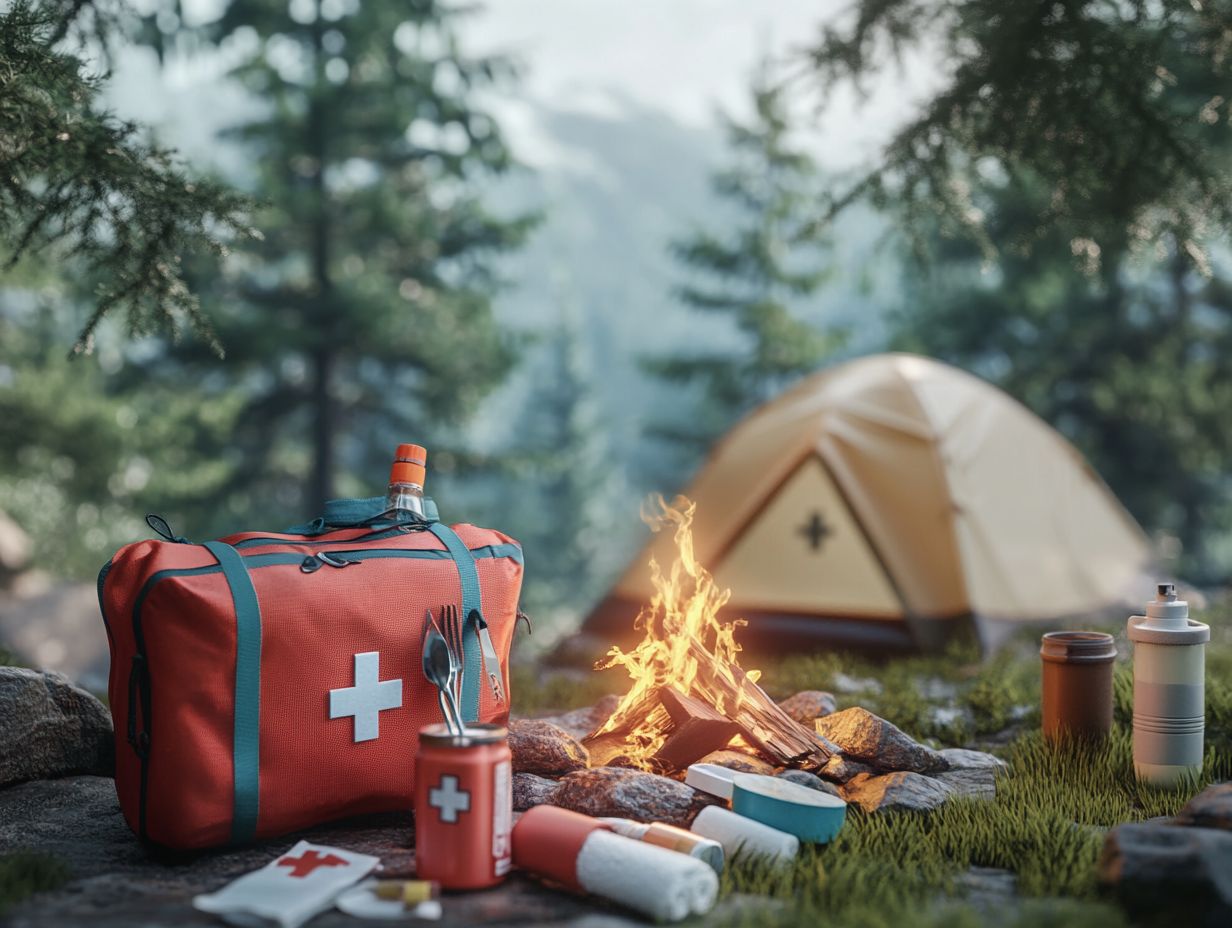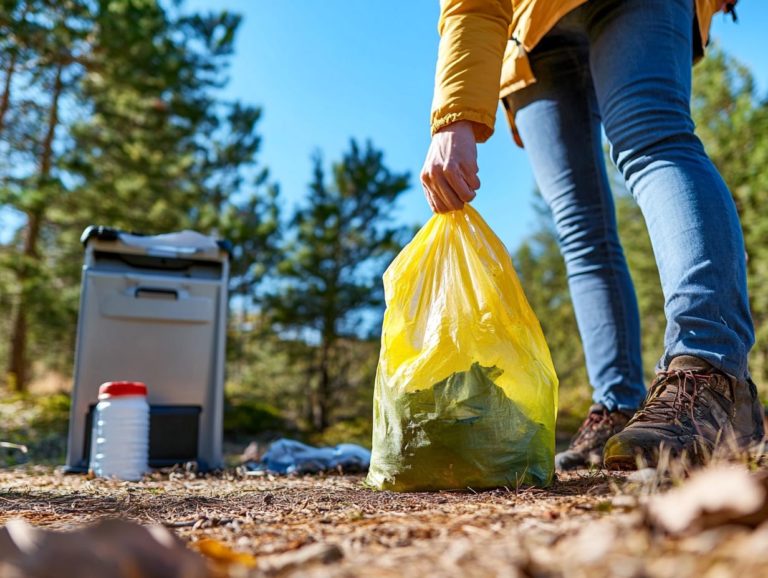Essential First Aid for Outdoor Cooking Mishaps
Cooking outdoors offers a wonderful opportunity to relish nature while enjoying the company of friends and family. However, it s crucial to be prepared for common injuries and accidents that can arise, from cuts and burns to food poisoning and heat exhaustion.
This article will guide you through essential first aid basics, techniques for handling outdoor cooking mishaps, and vital safety tips to help you prevent accidents. You’ll also discover when it s necessary to seek professional medical assistance.
Equip yourself with this knowledge and savor your outdoor culinary adventures with confidence and safety!
Contents
- Key Takeaways:
- Common Injuries and Accidents while Cooking Outdoors
- First Aid Basics
- Specific First Aid Techniques for Outdoor Cooking Mishaps
- Preventing Outdoor Cooking Mishaps
- When to Seek Medical Help
- Frequently Asked Questions
- What are the common outdoor cooking mishaps that require first aid?
- How can I prevent burns while cooking outdoors?
- What should I do if I accidentally cut myself while preparing food outside due to sharp knives?
- What are the symptoms of food poisoning, and how should I treat it?
- What should I do if someone gets a severe burn while cooking outdoors?
- How can I prepare a first aid kit for outdoor cooking mishaps to ensure injury prevention?
Key Takeaways:

- Be prepared for common mishaps in outdoor cooking such as cuts and burns. Keep a first aid kit handy and know how to assess and provide initial care in case of an accident.
- Specific techniques for treating cuts, burns, and food poisoning can help alleviate symptoms and prevent further complications. It’s also important to stay hydrated and prevent heat exhaustion while cooking outdoors.
- Prevent outdoor cooking mishaps by following safety tips and precautions, such as properly handling and storing food, using appropriate equipment, and being aware of potential hazards in the surrounding environment. Seek professional medical help if symptoms persist or if there are signs of more serious injuries or illnesses.
Common Injuries and Accidents while Cooking Outdoors
Cooking outdoors offers a delightful experience, but it does come with its share of risks. Common injuries and accidents think burns, cuts, and even more serious incidents can happen, particularly when children are part of the equation.
Being aware and prepared with a well-stocked first aid kit is crucial for minimizing kitchen-related injuries and ensuring safety during your outdoor escapades. Additionally, preparing for emergencies while cooking outdoors can help you master how to manage these injuries effectively, potentially saving you a trip to the emergency room and elevating your entire outdoor cooking adventure.
Cuts, Burns, and Other Common Mishaps
Cuts and burns are among the most frequent mishaps you may encounter while cooking, especially in outdoor settings where sharp knives and hot surfaces are often in play. To minimize these risks, consider these top outdoor cooking safety tips for beginners.
These injuries can vary from minor nicks and scrapes to more serious second- and third-degree burns that demand immediate attention. For anyone who takes pleasure in cooking, it s vital to know the right treatment options. Minor cuts can typically be treated with adhesive bandages, but deeper lacerations might require stitches and professional medical care.
In terms of burns, cooling the affected area under running water and applying specialized burn ointments can bring much-needed relief. Prioritizing cooking safety is crucial; utilizing cutting boards, consistently using oven mitts, and being aware of your surroundings can significantly minimize the risk of skin damage.
First Aid Basics
Grasping the fundamentals of first aid is essential for anyone who delights in outdoor cooking or activities. To stay safe while enjoying your culinary adventures, consider following essential tips for outdoor cooking.
A well-stocked first aid kit can be the deciding factor between a minor mishap and a serious injury that may require an emergency room visit.
First aid skills also include vital abilities such as CPR, enabling you to respond efficiently to a range of situations.
Assessing the Situation and Providing Initial Care
Evaluating the situation is your first step in providing effective first aid. You need to determine the nature and severity of the injury to decide if immediate medical attention is necessary.
Careful observation of the injured individual will help you identify critical factors, such as their level of consciousness, visible wounds, and any signs of bleeding or swelling. Don t overlook! Noting how the injury happened can help you provide better care.
Once you have a clear understanding, you can take care of the injury, focusing on stabilizing the injury and preventing further harm.
Practicing common injury prevention techniques like using appropriate safety equipment and being mindful of your surroundings can significantly reduce the likelihood of accidents. If the injuries appear severe, such as significant bleeding, difficulty breathing, or fractures, seeking emergency care is crucial for achieving better outcomes.
Specific First Aid Techniques for Outdoor Cooking Mishaps

Mastering specific first aid techniques is crucial for managing injuries that may occur during outdoor cooking adventures, especially knife cuts, burns, and eye injuries. Additionally, using essential safety gear for outdoor cooking can help prevent these incidents in the first place.
These skills enable you to respond promptly and confidently, ensuring your culinary escapades remain enjoyable and safe.
Treating Cuts and Burns
Treating cuts and burns quickly can reduce the risk of infection and enhance the healing process.
First, wash your hands thoroughly to prevent germs. For knife cuts, gently rinse the area with clean water to clear debris. If you have a more serious cut, applying pressure with a clean cloth can help control bleeding. Once the bleeding subsides, use an antibiotic ointment to ward off infection and seal it with an adhesive bandage.
For burns, run cool water over the affected area for 10-15 minutes. Avoid ice, as it can worsen tissue damage. Afterward, apply a sterile dressing or burn ointment to protect the area and facilitate healing.
Dealing with Food Poisoning
Food poisoning can strike unexpectedly due to food contamination, leading to symptoms that may require urgent care if not addressed promptly.
Common indicators include nausea, vomiting, diarrhea, abdominal cramps, and even a fever. Symptoms can appear just hours after consuming contaminated food, with varying intensity. Staying hydrated is vital, as persistent vomiting and diarrhea can lead to significant fluid loss. Use oral rehydration solutions or sip on clear broths to stabilize your condition.
If symptoms last more than 24 hours, or if you notice signs of severe dehydration, bloody stools, or a prolonged high fever, seek medical help immediately. Get the best care for a speedy recovery!
Managing Heat Exhaustion and Dehydration
Heat exhaustion and dehydration pose serious threats during outdoor cooking, especially in warm weather, and they require immediate attention.
Symptoms like excessive sweating, weakness, dizziness, and a rapid heartbeat can detract from the joy of cooking outside. Staying alert and recognizing these signs early is essential.
Proper hydration is key; drink water regularly and consider incorporating electrolyte-rich beverages into your routine. To prevent these issues, you should:
- Plan cooking during cooler hours,
- Opt for breathable fabrics, and
- Make sure to take breaks often in the shade to cool off!
By following these strategies, you can ensure outdoor cooking remains a safe and enjoyable experience.
Preventing Outdoor Cooking Mishaps
Preventing outdoor cooking mishaps is crucial for a safe and enjoyable experience, especially for families who frequently embark on outdoor adventures. Knowing how to handle cooking utensils safely outdoors can enhance your time spent in nature and create lasting memories without the worry of accidents.
Safety Tips and Precautions

Implementing effective safety tips and precautions can significantly minimize risks associated with outdoor cooking.
When diving into this enjoyable activity, having a fire extinguisher readily accessible can be a lifesaver in the event of an unexpected flare-up. Mastering knife handling helps prevent cuts and injuries, ensuring your cooking experience remains safe and enjoyable.
Maintaining a tidy cooking area is equally important, as clutter can easily lead to accidents and spills. By following these practices, you protect yourself and those around you while elevating your outdoor culinary adventures.
Stay safe and make unforgettable memories during your next outdoor cooking adventure!
When to Seek Medical Help
Recognizing the right moment to seek medical help is essential for safeguarding your well-being, especially regarding injuries incurred while enjoying outdoor cooking.
Signs and Symptoms that Require Medical Attention
Knowing when to seek medical help can be a lifesaver during outdoor cooking. Don’t ignore serious symptoms!
If you notice heavy bleeding that doesn t respond to direct pressure or experience a serious allergic reaction to food, these situations call for immediate care.
Additionally, if you develop symptoms of infection such as swelling, heat, or intense pain these should never be brushed aside.
A well-stocked first aid kit helps you manage minor cuts and scrapes effectively, but it s important to stay vigilant and know when a situation escalates. By being aware of these signs to watch for, you can make informed decisions about seeking urgent medical assistance, ensuring safety for yourself and those around you.
Frequently Asked Questions
Here are some common questions about first aid for outdoor cooking mishaps.
What are the common outdoor cooking mishaps that require first aid?
Some common outdoor cooking mishaps that may require first aid include burns, cuts, and food poisoning. Knowing what to do in case of an outdoor cooking accident can help you respond effectively.
How can I prevent burns while cooking outdoors?

To prevent burns while cooking outdoors, make sure to use heat-resistant gloves, aprons, and utensils. Keep a safe distance from the fire and always monitor the temperature of your cooking surface.
What should I do if I accidentally cut myself while preparing food outside due to sharp knives?
If you accidentally cut yourself while preparing food outside, immediately wash the wound with clean water and apply pressure with a clean cloth to stop the bleeding. If the cut is deep or requires stitches, seek medical attention.
What are the symptoms of food poisoning, and how should I treat it?
Symptoms of food poisoning include nausea, vomiting, diarrhea, and stomach cramps. To treat it, make sure to stay hydrated and avoid solid foods until the symptoms subside. If the symptoms persist, seek medical attention.
What should I do if someone gets a severe burn while cooking outdoors?
If someone suffers a severe burn, act fast! Remove them from the heat and cool the burn immediately by running cool water over the affected area for at least 10 minutes. Cover the burn with sterile gauze or a clean cloth and seek medical attention.
How can I prepare a first aid kit for outdoor cooking mishaps to ensure injury prevention?
To prepare a first aid kit for outdoor cooking mishaps, make sure to include items such as bandages, gauze, antiseptic wipes, burn cream, and pain relievers. Additionally, it’s essential to know how to prepare for safe outdoor cooking experiences, which should also involve having a first aid manual and emergency contact information in the kit.
Don’t wait! Prepare your first aid kit now to handle any outdoor cooking emergencies.






